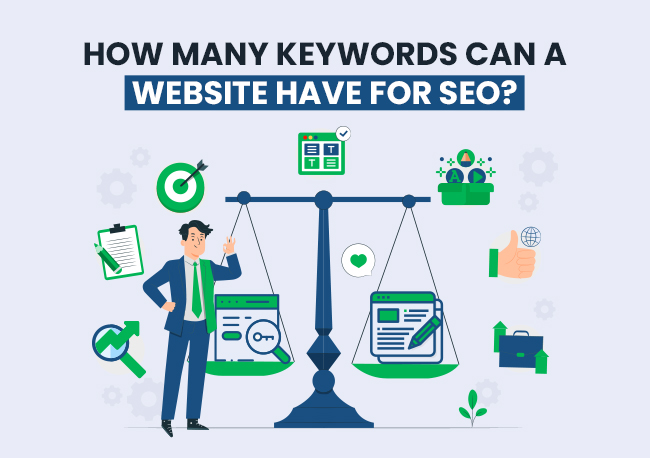Keywords and SEO – these two terms are the parallel circuit of digital marketing. Although, if they don’t have the right balance with each other, they can cause havoc in the SEO and ranking of your website on SERP.
To strike a balance between them, you first need to figure out the main question – How many keywords should I use for SEO? Wondering how you will unravel this mystery? Stop right there! Read below to determine the keyword density and some mind-boggling SEO strategies.
Before we jump directly to answer your question, let us first understand what keywords are and why they are important.
An Overview Of Keywords
Technically speaking, keywords refer to word(s) and phrases searched by web users on search engines. Keywords can comprise two, three, or more words. Generally, there are short-tail keywords or head terms that include 1 to 3 words and then come in long-tail keywords with 3 or more words. Besides these two main categories, there are numerous other types of Keywords in SEO, such as LSIs.
They are typically used in website content, blogs, meta descriptions, product descriptions, promoting services, ads, and other content types. You will know how keyword stuffing works if you are a marketer or a writer. However, if you are unaware, here’s an example to help you.
For instance – you are a marketing executive aiming to generate potential leads and increase sales for a clothing brand. Your primary goal would be to identify which keywords will be shortlisted and how they will be used.
Initially, you would analyze competitors and determine relevant and industry-specific keywords. These keywords will be included in product/service pages, blogs, ads, meta descriptions, and other relevant content types.
Finally, users looking to buy clothes will type a search query such as clothing brand near me. Your content will appear in the search results of your user’s query if you have the same or related keyword.
Also Read: Top Industries That Can Benefit From SEO In 2023
Start With Keyword Research
Starting with keyword research is key for creating content that resonates with your audience. Use tools like Google Keyword Planner or Ahrefs to find keywords with a good mix of search volume and low competition.
For example, imagine you own a small online store selling eco-friendly kitchenware. Keyword research may reveal that while “eco-friendly kitchen products” have a decent search volume, it is highly competitive.
Digging deeper, you might find “biodegradable kitchen sponges” or “sustainable kitchen cleaning tools” as lower-competition, high-intent keywords that better match what users are specifically seeking.
Keyword research also helps you understand user intent, ensuring your content matches what people are actually looking for and increases engagement.
Also Read: Which Businesses Benefits From Local SEO Practices?
Why Are Keywords Important In SEO?
If we had to answer in one line, it would be to achieve a desired goal based on your business and defined parameters. As mentioned above, having relevant keywords in the content means you are one step ahead in your game. The search algorithm comprehends the user’s search query and phrases in your content. Your content will be listed at the top in the SERPs if they have the right search terms and quality content.
- How Many Keywords For SEO Should Be Used?
Defining an ideal number of keywords for SEO is next to impossible because numerous factors are involved when including keywords in a piece of content, such as your objective, word count of the content, location, target audience, subject, and ad campaign.
Even after figuring out these aspects, the density still remains a question. Moreover, stuffing too many keywords is never the solution, as Google is inclined towards the naturally fitted keywords in the content. Plus, the cost of purchasing each keyword might burn a hole in your pocket.
So, exactly what keyword density should be right for SEO?
According to Hubspot, using 1 or 2 keywords for every 100 words of copy can be defined as good keyword density. A few search engines might respond well to 0.5% keyword density.
To identify the volume of keywords, you can leverage certain tools such as –
- Keyword Density Checker
- SEOBook Keyword Density Analyzer
- Copywritely Keyword Density Checker
- Semrush’s On-Page SEO Checker
Now that you know how many keywords to use for SEO, we shall move forward to the density of keywords for each page.
Also Read: 15 Best SEO Audit Tools For Your Website (Free+Paid)
- How Many Keywords Should You Focus On Per Page?
Previously we discussed the importance of keywords and how many of them should be used for SEO. Now, we will focus on other aspects of keywords per page.
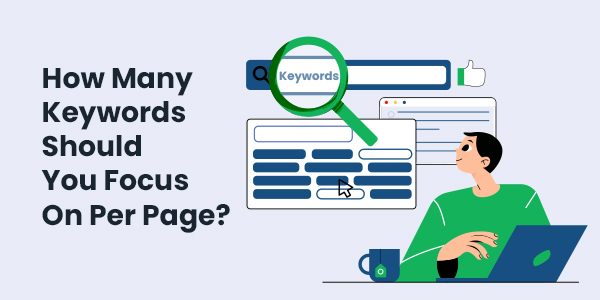
1. The Density of Keywords Per Page
As mentioned above, underlining a fixed amount of keywords is not feasible, and you need to consider numerous other factors to define the volume. Although marketers typically break down the keywords into two categories – 1 Primary or main keyword (the targeted keyword) and others as secondary keyphrases.
Although marketers typically break down the keywords into two categories – Primary or main keyword (the targeted keyword) and others as secondary keyphrases.
For instance – the primary keyword is luxurious cars in Dubai, and other keywords might be luxurious cars, cars in Dubai, top cars in Dubai, and so on. These keywords look similar, but they differ in terms of search variation and volume.
Besides these, you can always use the keyword formula to identify the required density.
Formula –
10 (keywords in the content) / 1000 (words in the content) = .001
Now, multiply this answer by 100 to get the exact density.
.001 x 100 = 1%.
This means you need 1% of keyword stuffing in 1000 words of content. Similarly, you can use this formula to define the volume of keywords for other content.
2. What Is Keyword Stuffing
Keyword stuffing refers to repeatedly using the same phrases or words in the content. Multiple keywords are usually stuffed to get better visibility and manipulate the position with the SERPs, but rather it makes you invisible.
3. Can A Website Have Too Many Keywords?
Absolutely not! The volume of keywords should always be balanced, not more, not less. Putting too many keywords can negatively affect your website/page on the SERPs. You must always include keywords naturally fitting with the content.
4. How Keyword Stuffing Can Impact Your Growth
Stuffing too many keywords negatively impacts a site or a page. Meaning visitors will head to another site as soon as they realize your site has too many keywords and adds little to no value to their search query. This outdated practice can not only obstruct user experience but also strike down search engine rules and SEO practices.
According to Google’s quality guidelines, “Filling pages with too many keywords or numbers can result in negative user experience likewise can impact your site’s ranking.”
However, you are still not at a disadvantage. The search algorithm will either overlook the keyword stuffing or cast the web page into the over-optimized category.
5. Why Drafting Relevant And High-Quality Content Is Important?
For ranking on SERP, you must create relevant and high-quality content. Instead of stuffing too many keywords, focus on creating content that entertains a reader and solves the purpose of visitors visiting your site/page.
Not only we but also Google agrees to this. Google rolled out a clearly defined statement — “Focus on creating useful, information-rich content that uses keywords appropriately and in context.”
Following this rule of thumb can boost the ranking of your site or page on SERPs. Google acknowledges and indexes content that fits well with its pre-defined guidelines.
Now that you have an overview of how many keywords per page, the next point is things to consider when determining the keywords.
Also Read: Best Content Management System Platform Optimized For SEO
How do you optimize content for keywords?
To truly drive traffic and conversions, optimizing for keywords is essential. Keyword optimization isn’t just about adding search terms—it’s about strategically crafting content to align with what users are searching for. By targeting high-traffic keywords, aligning with search intent, and implementing structured on-page SEO, you set the stage for consistent, quality traffic.
Let’s dive into methods that make your content easy to find and SEO-friendly, boosting your site’s visibility and engagement effectively.
- Targeting Keywords with Traffic Potential
Choose keywords with solid search volume and relevance to your niche. Start by researching terms that your audience is actively searching for. Tools like Google Keyword Planner, Ahrefs, or SEMrush can show you keywords that drive traffic.
- Aim for a balance between search volume and keyword difficulty to find terms where you can rank effectively.
- Mapping Your Keywords
Organize keywords by intent (informational, commercial, transactional, navigational) and topic. Use primary keywords as your main focus and support them with relevant secondary keywords. This helps search engines understand the context of your content and makes it easier for readers to follow.
- Aligning with Search Intent
Ensure your content matches the purpose behind a search query, whether it’s answering a question, providing a service, or selling a product. If searchers want to learn, prioritize educational content; if they’re looking to buy, emphasize product details and benefits. Matching intent increases engagement and ranking potential.
- Covering Comprehensive Information
Include all essential aspects of your topic. Anticipate what users want to know and provide answers in a detailed, structured format. By fully covering the topic, you increase the chances of ranking for a broader range of keywords and decrease bounce rates as users find all the information they need in one place.
- Making Content Easy and Enticing to Read
Format your content for readability: use short paragraphs, bullet points, headers, and visuals. Write in an engaging, conversational tone to maintain reader interest. Quality visuals, relevant examples, and clear explanations make complex ideas easier to digest and hold attention.
- Crafting a Compelling Title Tag and Description
Titles and meta descriptions are critical for attracting clicks in search results. Make your title catchy, relevant, and keyword-rich. The description should summarize the content’s value in a few words, prompting curiosity. Both the title and description should include primary keywords to signal relevance to search engines.
- Building Quality Backlinks
Backlinks from credible sites improve your content’s authority. Promote your content through guest posting, partnerships, or social sharing to attract natural links. High-quality backlinks demonstrate to search engines that your content is trustworthy, which is crucial for better rankings.
- Optimizing for Rich Snippets
Use structured data (schema markup) to increase the chances of your content appearing in featured snippets or rich results. This can include star ratings, images, or FAQs directly in the search results. Not only does this improve click-through rates, but it also enhances visibility and credibility.
Also Read: How to Make an SEO-Friendly Website?
How Many Keywords Should You Track?
The number of keywords to track depends on your business size, goals, and resources. For a small business focusing on niche areas, tracking 10–20 relevant keywords could provide valuable insights into performance without overwhelming data.
For larger websites with broader target audiences, 50–100 keywords per segment might be necessary to monitor multiple categories and capture market shifts.
To determine an effective range, consider keywords that truly represent user intent and align with your content strategy.
For example, an online bakery might start by tracking “birthday cakes online,” “chocolate cake delivery,” and “bakeries near me” to understand the search demand in their niche.
As they grow, they might expand to track keywords for specific products or seasonal offerings, like “holiday cupcakes” or “wedding cakes.”
Regularly reviewing and refining the keyword list is essential for adaptability. Often, high-value keywords change, making it important to evaluate whether your tracked keywords still align with search trends and conversion goals.
Tracking keywords this way can offer comprehensive insights while maintaining a manageable data scope.
Factors To Consider When Determining The Keywords Density
1. Size & Searches
This point depends entirely on the size and how many daily search queries appear on the site. Firstly, let us explain the size. Targeting multiple keywords may be difficult for a small site (12-15 pages). Under such circumstances, we recommend targeting less yet relevant, competitive, and high-density keywords.
However, the scope of targeting multiple keywords increases if you have a large site with 100 or more pages. For effective targeting, prioritizing collecting multiple relevant keywords would be a great idea.
Keyword targeting also depends on the search query. For instance – you have a salon website offering different services. However, your services are not clearly defined, and you are not targeting multiple keywords despite having considerable search queries.
Now, What Shall Be Done?
It is advisable to clearly define your services by listing multiple pages, targeting relevant keywords, and adding them to your content.
This will not only attract the targeted audience but also promote the ranking of your site on SERPs.
Also Read: How Is Ranking Different When Comparing PPC Vs SEO?
2. Niche & Target Audience
This is the second most important pointer when determining keywords. Niche here means identifying keywords related to your business/industry. They can also be referred to as industry-related keywords.
These keywords are relatively hard to determine and rank since they are industry specific, unlike trendy keywords that are easy to find and rank.
Generally, these keywords are targeted to prompt a user to take action for any purchase. Let’s assume you have sports shoes selling site. A user is all set with the decision to purchase new shoes online.
The user types a clearly defined search query – “Black Puma sports shoes near me”. Regardless of a sports shoe site, you don’t have this keyword on your site. So, what now? Unfortunately, your site won’t appear in the search results as you have included keywords such as footwear near me, shoes, and brand new shoes other than your niche.
If your business falls under the niche category, we recommend you target industry-specific keywords.
Besides this, your target audience is another major priority for identifying keywords. Specifying the target audience helps understand who is searching for the keywords that might lead to your website.
Suppose you are a tattoo artist whose target audience is people interested in or who gets tattoos frequently. However, you target the wrong or a wider range of audiences uninterested in tattoos. Doing so will gain you nothing. You will not get new customers at your storefront and will waste a lot of money.
We recommend you understand your target audience’s demographics, preferences, and other aspects to figure out which keywords to use to drive your target audience to get tattoos from you.
Also Read: How SEO and SEM Work Together?
3. Competitor Analysis
Competitor analysis is the last but not the least primary factor when finding keywords. These analyses are a strategic approach to finding the keywords used by your competitors on their websites. The goal of conducting this process is to target relevant keywords in the content and outrank your competition.
Suppose you have a toy store; you can look out for your competitors to check out the keywords they used and what volume they are following. By checking the keyword density, you can figure out how many times you should use the relevant keywords in the content to outperform them. The process gives an overall balance of keyword density.
This was our take on explaining the factors to highlight the density of the keywords. Let’s hop to the next topic — Keyword strategies.
4 Sure-shot Keyword Strategies To Advance In SEO
1. Focus On Keyword Research & Analysis
As mentioned earlier, keywords and SEO have a strong relationship. For ranking on SERPs, using the right and relevant keywords are essential. Publishing content without adding keywords is pointless, as these phrases are crucial for the growth of your business and achieving the desired outcome.
To do so, focus on determining and analyzing the search terms used by web users in search engines. If you are a renowned website, adding high-volume keywords will increase clicks and better traffic. However, if you are a startup website, we would recommend you consider low-volume keywords to jump ahead of the competition. You can make use of amazing SEO tools for this process.
Mind you, keyword research and analysis is not a one-time strategy. Industry experts claim to revisit your keyword strategy quarterly and at least 3 to 6 months before any campaign or promotion is necessary. Revisiting keyword strategy at regular intervals helps your site stay relevant and fresh.
Hence, focusing on keywords is vital, especially from SEO’s perspective. As this ensures you stay at the top of the game and gain maximum impact.
Also Read: What Is A Sitemap & Why Do You Need It?
2. Prioritize Both Long & Short-tail keywords
Previously, we gave you an overview of long and short-tail keywords. Here we will guide you on why they should be prioritized. Many marketers suggest supporting long-tail keywords as their search demand curve is high. Although, we recommend you prioritize both equally.
The content should have a mix of long and short-tail keywords to boost ranking and attract more users based on their search intent.
Both keywords have their benefits. For instance –
- Long tail keywords have low search volume and competition. They are highly specific search terms and have a low cost while giving a higher conversion rate.
- Short tail keywords have a high search volume and keyword difficulty. They are relatively less focused search terms since the intent is not clear. Their cost is high, and offers lower conversion rates.
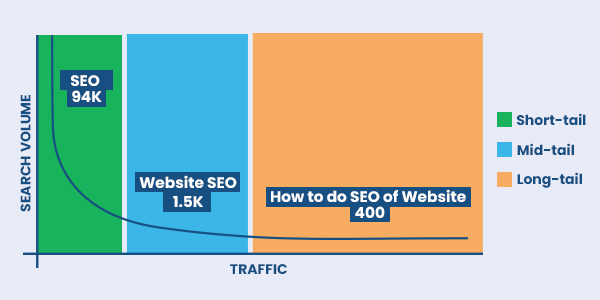
As shown in the example above:
- The keyword “SEO” has a higher search volume, but when it comes to the chances of traffic engagement, It is very low.
- The keyword “Website SEO” in between has a chance of higher traffic engagement than the short tail keyword.
- Now, when we come to the keyword “How to do SEO of Website” which has the lowest volume but it has the chance of higher traffic engagement as compared to short & mid-tail keywords.
This shows that you can’t ignore long-tail keywords at all, even though it has low volume. Although, mapping out a powerful keyword strategy based on your objectives will lead to a consistent and quick outcome.
3. Never Disregard Primary, Secondary, and Tertiary Keywords
While many might be aware of primary, secondary, and tertiary keywords, a few are still not acknowledged with these three types. To outline –
- The primary keyword is believed to be the main keyword in content. It is targeted at the top in the title, meta description, URL, and the first few lines of the content since it has higher conversion rates and search volume.
- A Secondary keyword refers to the supporting keyword in the content. The secondary keyword is usually partnered with the primary keyword for the perfect balance of keyword density & content and to drive relevant users.
- Tertiary or LSI keywords are like synonyms of a word or phrase in the content. For instance – upon searching for Instagram, Facebook, like, follow, Twitter, and other such autocomplete options will also appear.
Adjoining these three types will increase the relevancy and visibility of your content in the SERPs. This also ensures you drive relevant traffic to your website.
4. Work on Keyword Mapping and Silos
These two are the most widely used concepts in SEO to manage and optimize the content on search engines. Keyword mapping refers to dedicating keywords based on the topic or specific elements for each page on your website. The main purpose of keyword mapping is to target a group of keywords that naturally blends with the content.
Example of a Web Development Company
to Understand Keyword Mapping
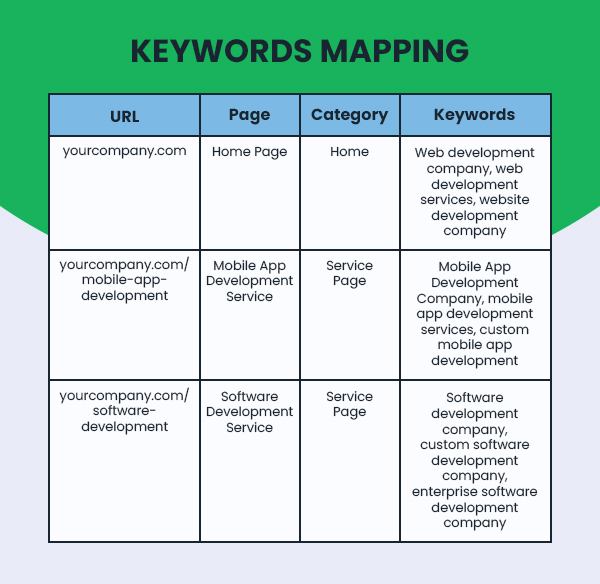
Silos is a method of structuring website content based on the theme of your keywords. The logical hierarchy is created for seamless navigation and understanding of content. Silos are generally focused on the broader theme with more subtopics.
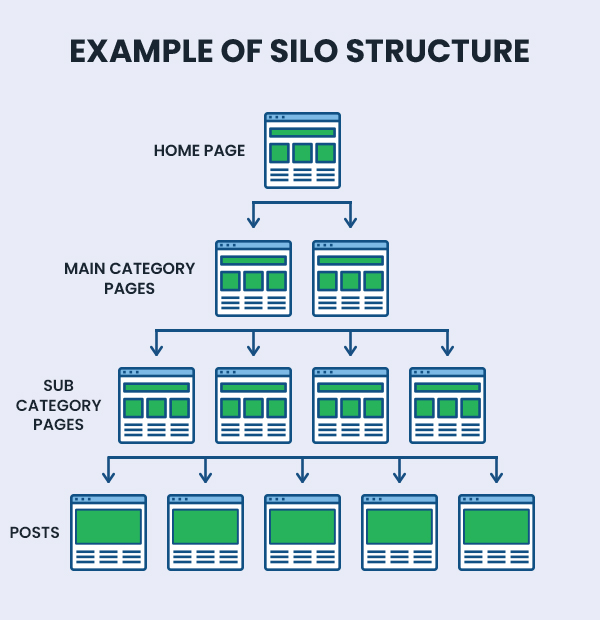
Leveraging these strategies are important for ranking on SERPs and optimizing website content. You can also improve the relevancy and make the content more coherent.
Also Read: Website Development Checklist To Help Create Your First Website
A Golden Rule Of SEO
While we have discussed the importance of keywords in content, we have also mentioned that there is no fixed number to determine the density. Focusing solely on the density of the keywords won’t help you achieve the desired result.
Prudent & natural use of keywords and drafting quality, unique, & relevant content that engages readers and solves the users’ queries is a sure-shot way to grow on SEO.
To Sum Up
SEO is a tricky strategy in digital marketing, but when used wisely, it can bring enormous results, but one wrong step and all your hard work can go in vain.
We suggest you follow the best practices of SEO, search for the right keywords, craft compelling content, and don’t forget to track your growth. Keeping an eye on these nitty-gritty of SEO will certainly help you thrive in the SERPs.
FAQs
Place keywords naturally in key areas: your page title, headings, intro paragraph, image alt text, and meta descriptions.
For example, if your primary keyword is “home workout tips,” ensure it appears in the title, headings, and a few times in the content body.
Yes! Keyword stuffing can confuse readers and harm SEO. Google favors natural, well-written content, so focus on relevant keywords that add value to the topic.
Use tools like Google Keyword Planner or Ahrefs. Your primary keywords should be your main focus, while secondary keywords should support it.
For example, if “summer fitness tips” is primary, “home workout” could be secondary.
A primary keyword provides focus, helping your content rank better for a specific search. Think of it as the main theme, making it easier for search engines to categorize your content.
Secondary keywords broaden your reach and answer related questions.
For example, if “web hosting for beginners” is primary, secondary keywords like “affordable web hosting” improve relevance and search potential.
A balanced approach is key. Aim for a primary keyword in each major section and a few related keywords where relevant. Always prioritize readability.
Yes! Targeted keywords attract the right audience and increase visibility. Focusing on a keyword or phrase ensures your content reaches people actively searching for that topic.
